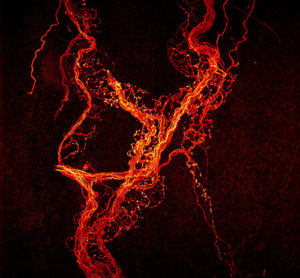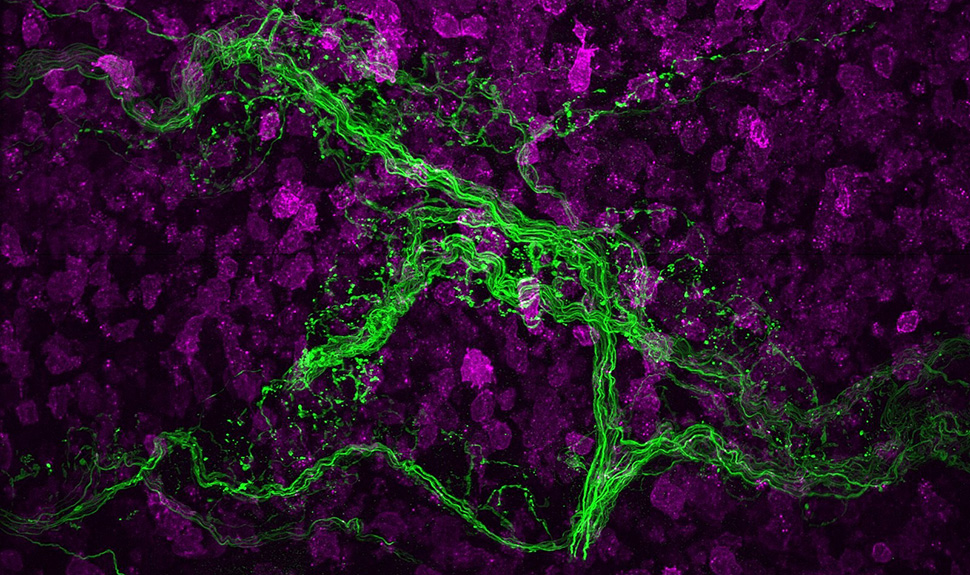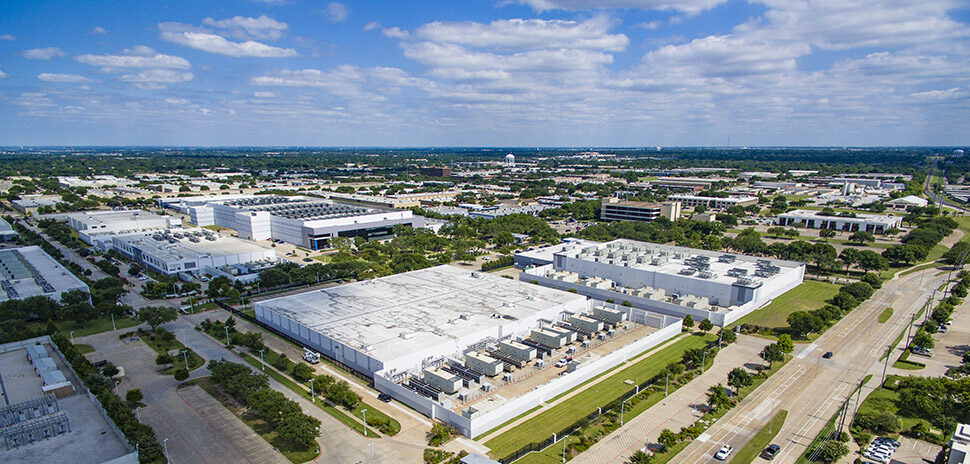![]() Every week, we do a little research of our own. We’re looking for scientists, professors, engineers, entrepreneurs—anybody, really—engaging in research and development across North Texas.
Every week, we do a little research of our own. We’re looking for scientists, professors, engineers, entrepreneurs—anybody, really—engaging in research and development across North Texas.
There’s plenty of good work being done. If you want to put R&D under your microscope, sign up for our e-newsletter.
UTSW researchers develop high-res microscope for subcellular views
A new 3D microscope, which can view smaller specimens with greater clarity, has been developed by researchers at UT Southwestern Medical Center. The new device is expected to speed up the understanding of biological processes and aid the search for potential treatments.

Nerve fibers (red) without stem cells. [Image: Courtesy The Fiolka laboratory and the Microscopy Innovation Laboratory, UTSW]
The microscope has the highest resolution of its type and can image large structures—such as in a mouse brain—in tissues that are chemically treated to be nearly transparent. It can reduce imaging time from weeks to hours, according to a statement.
The device is called a light-sheet fluorescence microscope, or LSFM. When compared with other microscopes compatible with cleared-tissue imaging, the LSFM has the world’s highest resolution in all three dimensions and overcomes many other challenges, according to a statement.
UT Southwestern researchers Dr. Reto Fiolka and Dr. Kevin Dean are known for developing advanced microscopes when their colleagues come to them for help solving scientific problems, according to a statement. They are corresponding authors of the study published in the current issue of Nature Methods, which details their achievement of cleared-tissue LSFM at the highest resolution to date.
“By chemically clearing a tissue or an organ, the depth over which an optical microscope can deliver a sharp image is dramatically increased. However, imaging with subcellular resolution has remained out of reach,” Fiolka, who is an assistant professor of Cell Biology and is also in the Lyda Hill Department of Bioinformatics, said in a statement. “In this research, we developed a microscope that can image large specimens like an entire mouse brain or kidney with high resolution, irrespective of the clearing protocol.”
The study received support from the Cancer Prevention and Research Institute of Texas and the National Institutes of Health.

Chemically cleared hippocampal neurons imaged with the cleared-tissue light-sheet fluorescence microscope. [Image: Courtesy The Fiolka laboratory and the Microscopy Innovation Laboratory, UTSW]
UNT prof’s research finds polluted air may contribute to weight gain
The Hollies, the Hall of Fame British rock band of the 1960s, once sang, “Sometimes all I need is the air that I breathe, and to love you.”

Amie Lund
Amie Lund, a cardiovascular toxicology researcher with the University of North Texas has discovered that, sometimes, all you need to gain weight is the air that you breathe, if it’s polluted. Lund found that exposure to certain air pollutants may cause weight gain, especially when that polluted air is combined with a high-fat diet.
Lund is looking into how pollution from automobile exhaust affects the growth and signals of fat cells. Car exhaust can trigger responses in the body that can lead to increased fat cell growth and inflammation, which are associated with obesity and cardiovascular disease, according to a statement.
“When people think of the root causes of obesity they often think of genetics and diet,” Lund said in a statement. “But, there are external factors, such as environmental pollutants, that stress the systems of our body constantly and may play a role in contributing to diseases like obesity.”
According to Lund’s research, when a person Inhales automobile and diesel exhaust it alters signals generated and received by the fat cells, which can cause those cells to grow 12 to 25 percent larger in size or even increase in number.
UTA study finds no link between violent video games and violent acts
You hear it often—violent video games can lead to real-life acts of violence. But a researcher at the University of Texas at Arlington’s new study with more than 15,000 participants found no link between violent video games and violent acts.

Michael Ward
Michael Ward, an economics professor in UTA’s College of Business, published the study “Adolescent Video Game Playing and Fighting Over the Long-Term” in the peer-reviewed journal Contemporary Economic Policy.
“This is my fourth analysis using a fourth methodology and a fourth dataset on actual outcomes that finds no violent effects from video games,” Ward said in a statement.
Ward’s study looked at data from a nationally representative sample of U.S. adolescents in grades seven through 12 between April 1995 and December 1995, according to a statement. More than 15,000 participants were followed into young adulthood with four waves of in-home interviews, while the final interviews were conducted when the participants were between ages 24 and 32.
While raw data showed that fighting later in life is related to playing video games as an adolescent, a closer review showed that most is because, relative to females, males both play video games more often and fight more often—not solely an effect of video games, according to a statement.
![]()
Get on the list.
Dallas Innovates, every day.
Sign up to keep your eye on what’s new and next in Dallas-Fort Worth, every day.


































































